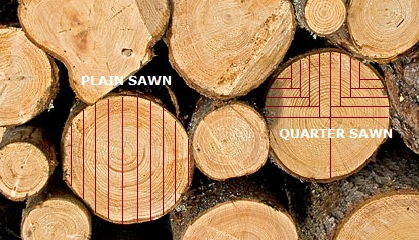Radiant Heating under Softwood and Hardwood Floors
When wood is selected as a finished floor covering material, may questions and concerns arise about its’ compatibility with an underfloor heating system.
Humidity
It is necessary to acclimatize the wood to the interior of the house prior to installation and ensure that it is sufficiently dry. This process may require anywhere from 4 to 14 days depending on the wood species. Surface of the cement in which the heating cable is submerged must also be dry. Cement dry times vary by type and thickness and should be checked on the product label or with the manufacturer.
Plain Sawn vs. Quarter-Sawn
Plain sawn lumber is generally not recommended for flooring because its’ radial grain orientation allows the wood to distort over time into a bow-like shape. Quarter sawn wood is a preferred choice for flooring installations because its grain direction makes it more resistant to shrinkage and deformations over time. Furthermore, the narrower planks tend to show fewer gaps with wear and humidity changes then the wider ones.
Hardwood vs. Softwood
Hardwood is a more common and practical choice of flooring due to it’s resistance to wear and shrinkage/expansion due to humidity changes. Among the hardwood species used for floors, the following are among the most common: Oak, Cherry, Maple, Walnut and Birch.
Softwood (Pine, Fir, Cedar) is not a common choice for flooring since they can be easily damaged and require special care. Softwood is also a much less practical choice for use with floor heating because it is less dense and therefore is less efficient in transferring radiant heat.
Pros and Cons of Wood Floors for Radiant Heating
Pros: Wood is a beautiful and clean building material, with excellent acoustic and wear-resistance properties. It’s hypo-allergenic and is free from chemicals which cause or complicate respiratory health conditions. Properly finished wood is easy to clean and maintain and is a good investment which increases the value of the property.
Cons: While it is possible to select the right type and thickness wood floors to go along with the radiant heating system, the information above should be carefully considered to ensure compatibility, efficiency and trouble-free operation of the system.
Why R value is important
First and foremost, it is important to check the R-value of the flooring based on the wood species and its’ thickness with the manufacturer or product distributor.
R-value is a critical factor, as indicates the thermal resistance of a particular material or, in our case – wood flooring, to transferring heat. For most electric floor heating systems, including, the acceptable combined* R-value of the flooring above the heating cable or mat should not exceed a total of 1.0. Flooring which is too thick or has a high R value may act as insulator, reducing flooring surface temperature and system efficiency.
*Combined R value of the materials (hardwood, plywood, etc.) above the heating cable is calculated by adding the R values of each individual layer.
Installation: Concerns and Solutions
One of the main issues with installation of the wood floors over the radiant floor heating system is the risk on penetrating the heating element with screws or nails.
Since wood flooring cannot be nailed to the cement floors, the solution is to install so-called “wood sleepers”. These are strips of wood (or plywood) typically 3/8” to 1/2” thick and are 1-2” wide, which are installed between (in parallel to) the heating cable runs to create a surface for nailing the hardwood flooring onto. The spacing between the sleepers may vary based on the length of the hardwood plank, and the recommended minimum is 12” apart OC (On Center). Channels between the sleepers are then filled with self-leveling cement and when it dries, the flooring is installed on top. Depending on the type of subfloor beneath the heating cable (such as ground level or basement slab), a moisture barrier may be required.
Other options:
Tile Floors - includes ceramic, porcelain and natural stone.

